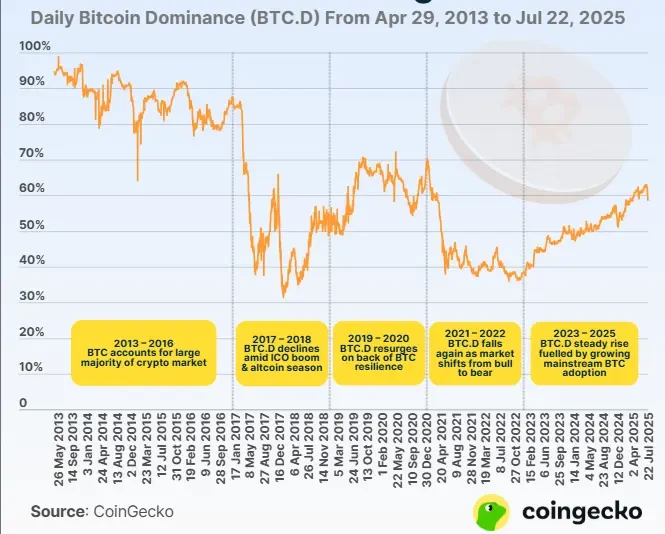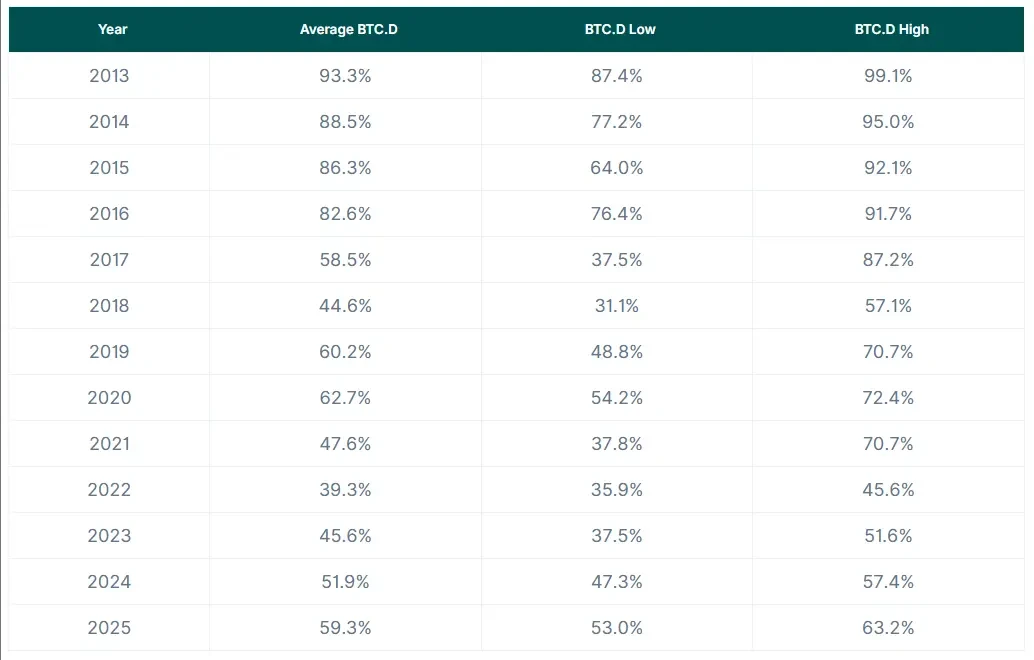Original author: Coingecko
Original translation: Felix, PANews
The study examined Bitcoin’s daily market share between April 29, 2013 and July 22, 2025, using data from Coingecko.
How has Bitcoin's market share evolved over the years?
From 2013 to 2025, Bitcoin's market share in the crypto market fluctuated widely, ranging from a historical low of 31.1% to an early high of 99.1%. During this period, Bitcoin's daily market share remained at 50.0% or higher for two-thirds of the time. In other words, Bitcoin dominated the crypto market for 8 of these 12 years.
From an annual perspective, Bitcoin's average daily market share has declined for five consecutive years, from 93.3% in 2013 to 44.6% in 2018. The market share rebounded to 60.2% in 2019 and 62.7% in 2020, then fell to 47.6% in 2021 and 39.3% in 2022.
Since 2023, Bitcoin's market share has risen steadily again, with annual averages of 45.6% in 2023, 51.9% in 2024, and 59.3% so far in 2025. This means that Bitcoin's market share in 2025 is currently hovering around the 12-year daily average of 62.5%.
Bitcoin's market share is currently hovering around the 12-year average of 62.5%.

Statistical date: April 29, 2013 to July 22, 2025
Key levels of Bitcoin market share
Bitcoin’s market share has been well below 90% since February 2016. This reflects a turning point in the maturation of the crypto market following the ICO boom and the first altcoin bull run in 2017, when the number of major altcoins increased and their market capitalization grew.
Similarly, after barely recording 70.7% on January 3, 2021, Bitcoin's market share has declined and has remained below 70%. This means that in the past 12 years, Bitcoin's daily average market share has only reached 70% or higher one-third of the time. Whether Bitcoin's market share will break the 70.0% threshold again remains to be seen.
It is worth noting that on April 7, 2025, Bitcoin's market share rose to 60.5%, breaking the 60% threshold for the first time in more than four years. The last time Bitcoin's market share exceeded this threshold was on March 15, 2021, when it reached 60.6%. In the past 12 years, Bitcoin's market share has been below 60.0% for more than half of the time.
Bitcoin market share development history (2013 - 2025)
The annual average, minimum and maximum values of Bitcoin's market share from 2013 to 2025 are as follows.

2013-2016: Bitcoin Monopolizes the Crypto Market
Between 2013 and 2016, Bitcoin dominated the crypto market, with its daily average market share ranging between 82.6% and 93.3% per year. During this emerging period, despite a correction in Bitcoin prices and the first major U.S. regulatory action against then-Bitcoin exchange Mt. Gox, Bitcoin’s market share in the crypto space peaked at 99.1% on May 29, 2013.
Despite Bitcoin’s overwhelming majority share of the crypto market, its market share has experienced three of the largest swings during this period:
- On March 29, 2014, Bitcoin’s market share dropped 10.9 percentage points from the day before, from 89.6% to 78.7%. This occurred after the collapse of Mt. Gox and can be attributed to the sharp rise in the total crypto market capitalization that was subsequently corrected.
- On January 15, 2015, Bitcoin’s market share dropped dramatically by 16.2 percentage points, from 80.2% to 64.0%. This sharp drop was driven by the price of Bitcoin falling from $221 to $172 the previous day, marking the bottom of the bear market after the hack of the Bitstamp centralized exchange.
- On January 16, 2015, Bitcoin's market share rebounded to 80.7%, up 16.7 percentage points from the previous day, and the price of Bitcoin also rebounded to US$211.
2017-2018: ICOs and altcoins overshadow Bitcoin
Over the next two years, Bitcoin’s market share fell further, reaching new lows during the ICO-driven altcoin bull run in 2017 and the bear market in 2018, well below the 80% and 70% thresholds. On May 16, 2017, Bitcoin fell below 50% for the first time, reaching 48.5%. Notably, on January 16, 2018, Bitcoin’s market share hit a record low of 31.1%, with the price of Bitcoin plummeting from $14,412 to $11,724.
In the past 12 years, Bitcoin's market share fluctuated the most in 2017, from 87.2% at the beginning of the year to more than half to 37.6% by June 19. In the second half of the year, Bitcoin's market share briefly rose, then fell to an annual low of 37.5%, then rebounded to 66% on December 7, and finally closed at 38.9% at the end of the year.
On the other hand, Bitcoin's market share showed an overall upward trend in 2018, increasing from 37.4% at the beginning of the year to 52% at the end of the year.
2019-2020: Bitcoin regains dominance as third halving approaches
In 2019 and 2020, Bitcoin regained its dominance of the crypto market, with its share ranging between 48.8% and 72.5%. Bitcoin’s re-emergence in this period was the result of a combination of factors: primarily the anticipation of the third Bitcoin halving in May 2020, as well as investors’ return to quality assets after the ICO boom, early institutional interest in Bitcoin as “digital gold”, and Bitcoin’s role as an on-ramp during the “Summer of DeFi” in 2020.
2021-2022: Altcoins regain influence
During the bull run in 2021 and the crash caused by the epidemic in 2022, Bitcoin's market share continued to decline by 30.9 percentage points, from 69.5% to 38.6%. In the past two years, as altcoins gradually gained a foothold and began to exert greater influence in the crypto market, Bitcoin's market share continued to decline.
During this period, Bitcoin’s share of the crypto market was below 50% eight out of every ten days. That means Bitcoin’s share was below 50.0% 624 out of 730 days.
Specifically, in 2021, although the price of Bitcoin rose from $29,022 to a record high and closed at $47,192 at the end of the year, an increase of 62.6%, Bitcoin's market share still fell from 69.5% at the beginning of the year to 38.2% at the end of the year. In contrast, during the same period, the total market value of the entire crypto market outperformed Bitcoin, soaring from $776.4 billion to $2.3 trillion, an increase of 200.6%.
In 2022, Bitcoin’s market share started at 37.9% and ended at 38.6% as the price of Bitcoin fell 64.2%, in line with the 64.1% drop in the entire crypto market. In other words, Bitcoin itself was directly affected by the Terra-Luna and FTX crashes, and investors turned to fiat currencies to reduce risk.
2023-2025: Bitcoin Goes Mainstream
Over the past three years, Bitcoin's market share has steadily increased, from 38.4% at the beginning of 2023 to 58.5% so far in 2025. The recovery in Bitcoin's market share reflects a structural shift in the crypto market, as Bitcoin has gained mainstream recognition and institutional adoption, thanks to the approval of the US spot Bitcoin ETF in January 2024 and the increasing clarity of the regulatory environment after the FTX debacle.
It is worth noting that Bitcoin’s market share has become increasingly stable, with smaller fluctuations ranging from -1.2 percentage points to +1.6 percentage points. In contrast, between 2013 and 2016, Bitcoin’s market share fluctuated from -16.2 percentage points to +16.7 percentage points; and between 2017 and 2022, it fluctuated from -8.8 percentage points to +7.0 percentage points.
- 核心观点:比特币市占率波动大,近年稳步回升。
- 关键要素:
- 2013-2016年市占率82.6%-93.3%。
- 2021年跌至38.2%,2025年回升至59.3%。
- 现货ETF获批推动2023年后市占率上升。
- 市场影响:机构认可增强比特币主导地位。
- 时效性标注:中期影响。



